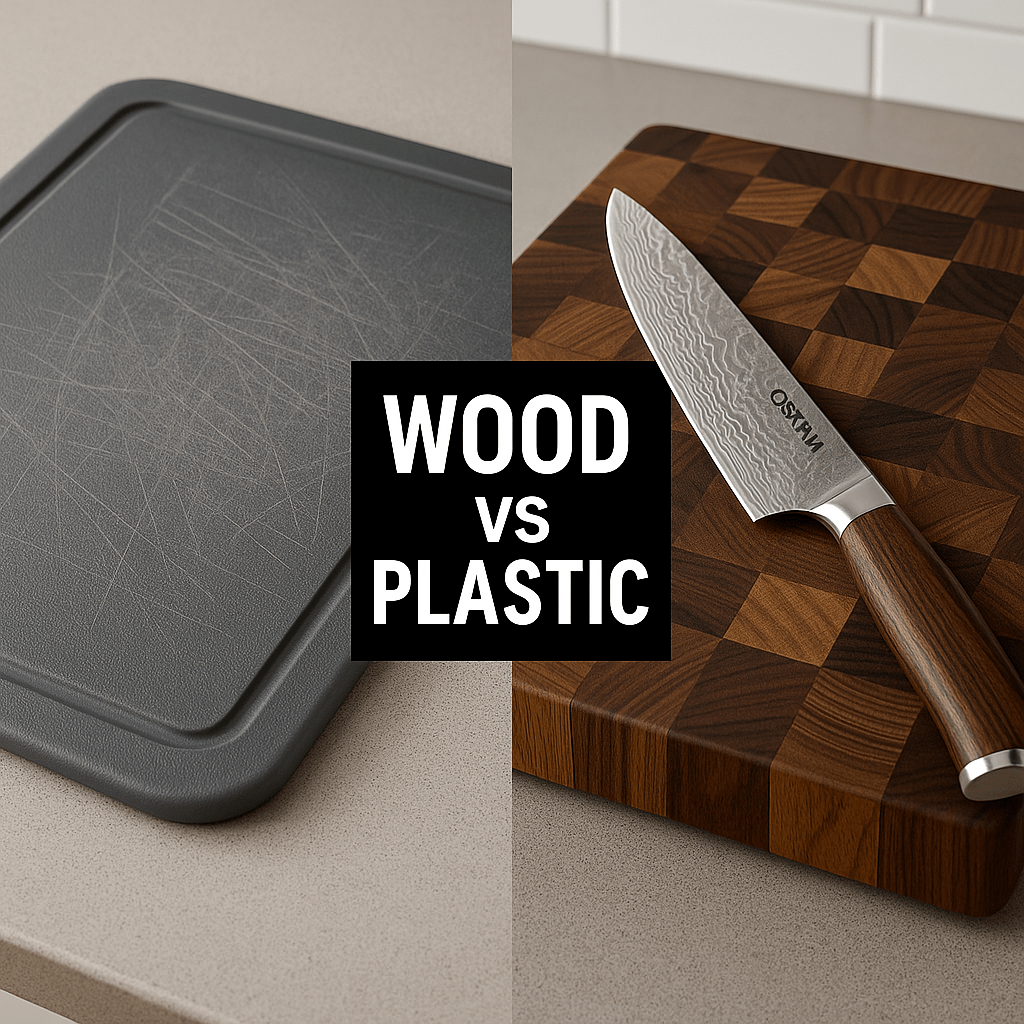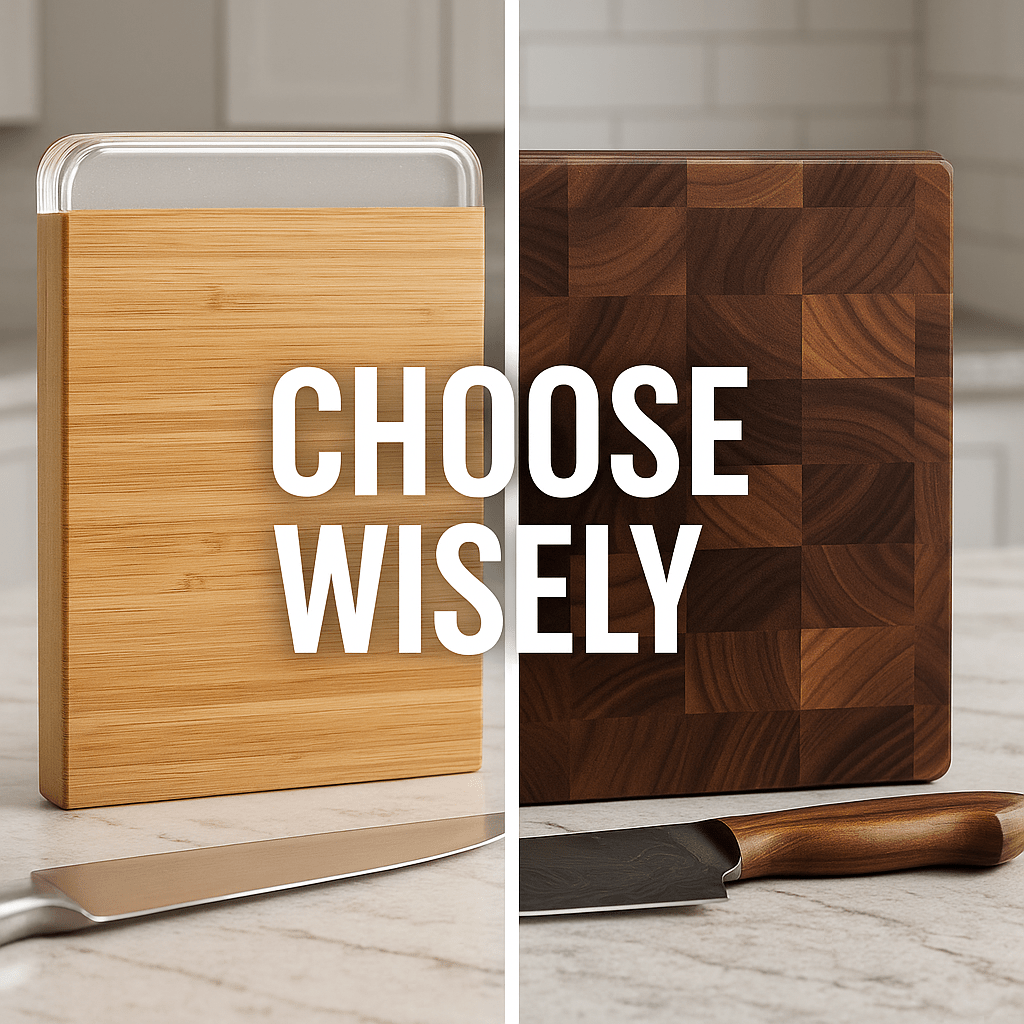
Wooden Cutting Board vs Plastic – Which Is Better for Your Knives?
It’s one of the most common kitchen debates: wood vs plastic cutting boards. While both are widely used, they offer very different experiences — not just in maintenance and hygiene, but also in how they affect your knives. For knife lovers, especially those who own OSERM Damascus knives, understanding the difference is essential to protecting your investment.
1. The Knife’s Perspective
Your knife’s edge is a delicate structure, even if it’s made from high-end VG-10 Damascus steel. Each cut interacts with the board’s surface on a microscopic level. A hard, unyielding surface can crush or fold the fine edge, while a forgiving surface preserves sharpness longer.
So, the real question isn’t just “Which is cleaner or cheaper?” — it’s “Which one respects your knife?”
2. Wooden Cutting Boards: The Classic Choice
Wooden boards — especially end-grain models made from walnut, maple, or acacia — are the gold standard for knife care. Their natural fibers absorb impact and allow the blade to slip gently between them without causing damage.
- Pros: Gentle on knives, self-healing surface, aesthetically beautiful.
- Cons: Requires regular oiling, not dishwasher safe, heavier to handle.
The reason chefs and enthusiasts favor wooden boards is simple: they maintain the cutting edge. For Damascus knives, which feature layered, hardened steel, a wooden board ensures that the knife retains its sharpness and intricate grain pattern.
3. Plastic Cutting Boards: The Convenient Contender
Plastic boards — typically made of HDPE (high-density polyethylene) — have gained popularity for their ease of cleaning and low cost. They’re lightweight, non-porous, and dishwasher safe, making them ideal for quick use in busy kitchens.
- Pros: Hygienic, lightweight, easy to sanitize.
- Cons: Knife marks appear quickly, grooves trap bacteria, harder on edges than wood.
While plastic may seem convenient, its surface doesn’t “heal.” Each cut leaves a groove, and over time, those grooves harbor moisture and bacteria — even after washing. More importantly, the surface resistance of plastic boards can dull knife edges faster, especially if used with fine Damascus blades.
4. Knife Longevity: The Real Difference
A study by the University of California found that wooden boards not only outperform plastic in terms of edge preservation but also in bacterial resilience. Wood’s natural antibacterial properties, combined with regular oiling, make it surprisingly hygienic when maintained properly.
Plastic, on the other hand, tends to wear out faster and becomes rougher over time, accelerating knife dulling. Even with frequent cleaning, it can’t match the tactile comfort or longevity of quality wood.
5. OSERM’s Expert Recommendation
For your OSERM Damascus knives, we recommend using a waxed acacia or walnut end-grain board. This type of board is firm yet forgiving, ensuring your knife glides smoothly while retaining its sharpness.
Pair it with proper maintenance — a ceramic honing rod and periodic whetstone sharpening — and your OSERM blades will last for decades.
6. Maintenance Tips
- Oil your wooden board every 3–4 weeks with food-grade mineral oil.
- Use mild soap and warm water; never submerge in water or put in the dishwasher.
- Use separate boards for meat and vegetables to maintain hygiene.
- Flatten warped boards using moisture control and weight, not heat.
7. When to Use Plastic Boards
Plastic boards still have their place — particularly for cutting raw meat, poultry, or seafood. They’re easier to disinfect and can go in the dishwasher. However, once deep grooves appear, replace them promptly to prevent bacterial buildup.
8. Verdict: Wood Wins for Damascus Knives
While plastic boards are convenient, wooden boards are superior for knife longevity, cutting comfort, and kitchen aesthetics. A high-quality end-grain board not only enhances performance but also matches the craftsmanship of your OSERM Damascus knives.
Weekly Deal 🔥
Pair your OSERM Damascus knife with the OSERM Premium End-Grain Walnut Cutting Board — crafted to protect your edge and elevate your kitchen setup.
You Might Also Like
- How to Choose the Right Cutting Board for Your Knives
- Knife Care 101 – How to Make Your Knives Last Longer
- Sharpening vs Honing – What’s the Real Difference?
Tags: wooden vs plastic cutting board, knife care, OSERM Damascus, end-grain board, knife maintenance, kitchen essentials, VG-10 steel






